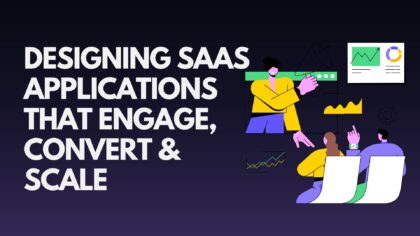Top Tips for Improving Your Website’s B2B Conversion Rates [Video]
It’s time to stop settling for average!
The average B2B conversion rates, i.e., how many of your website’s business visitors turn into leads and eventually become customers, are tough to come by because most companies closely guard this information. Available figures show that conversion rates are incredibly low, around 2.55%. In that context, a 7% conversion rate might sound downright impressive. That’s the average for software/SaaS companies, which often have higher conversion rates because they offer free trials. Yet even with that 7% conversion rate, more than 90% of website visitors leave without engaging with the company. Sounds…much less impressive.
Failure to engage such a large segment of your visitors means you’ve missed a fleeting opportunity to connect. Perhaps you’ve missed the mark with your content, or your website design discourages people from filling out that contact form. If you’re ready to transform your website into a lean, mean conversion machine, check out these tips.
Create Meaningful Offers for Your Buyer Personas
Buyer personas are fictionalized characters that represent your ideal audience. For B2B companies, developing these personas requires a deep dive into what makes your ideal customer tick at the office: their competencies and responsibilities, their professional growth, and even the problems that keep them up at night. Understanding your buyer personas is the first critical step toward creating online content to genuinely engage your prospects and customers.
- Answer the questions your buyer personas are already asking. Consult your sales team to determine what questions your buyer personas frequently ask. Use these to guide editorial calendar development. Note that this doesn’t mean you simply answer FAQs about how your product works. Consider the benefits your clients are looking for, what problems your company solves for them, and what objections they raise during the sales process. For example, if prospects are often concerned with implementation time and costs, publish an industry-specific “Best Practices” guide for smooth software implementations.
- Build around the content that already performs well. If your organization already has a blog, look at the articles that drive the most traffic to your site and do more of the same. The popularity of printed content can also provide insight: What marketing collateral do people pick up from your convention table or request from your sales team? Instead of simply putting these documents online as PDFs, develop them into unique online resources.
- Address emerging trends and issues in your clients’ industry. Your clients work in an entire industry ecosystem, and your product or service is likely only a tiny part. Expand your scope to include content that delves into the “big issues” they face. These might include resources like a forecast on M&A activity in the industry and its impact; or an in-depth look at how automation and machine learning affect their field.
- Don’t forget your existing clients and customers. Even after prospects have become customers, they can still benefit from your company’s insights. Consider how each buyer persona will use your product or service and develop resources accordingly. Say, for example, you’ve launched a new reporting feature in your accounting software. “End User Ursula” might be interested in using that feature, while “VP Veronica” will likely want to know how that reporting feature supports operational visibility or employee accountability.
Choose the Right Barriers to Entry
When is the last time you clicked on an offer for a checklist, case study, or another online resource, only to be faced with a contact form longer than an Ayn Rand novel? Did you fill out the form, or did you retreat to Google to find the information elsewhere? Form length matters, and shorter is often–but not always–better, especially in the B2B world, where prospects are more accustomed to providing more work-related information. Context is essential to determine the ideal length and format for contact forms.
- Consider user expectations. If you’re inviting people to join your organization’s email list, they’re expecting to share very little beyond their email address. However, for a more scarce resource, such as a case study in a niche field or a perspective paper featuring industry experts, your visitors will expect to provide more information about themselves. Tailor your form length to your visitors’ perceived value of the offer.
- Don’t be afraid to opt for quality over quantity. Remember the purpose of every offer you create: to generate qualified leads for the sales team. While a lengthier form might dissuade some visitors, it will also “weed out” those not interested in building a relationship with your company. Furthermore, asking the right questions will give your sales team the information they need to reach out to these new leads more strategically in a way that benefits both your organization and the lead. Ultimately it is better to receive fewer high-qualified leads than a mountain of unqualified ones.
- Think about the design elements around your contact form. Your contact form is ripe for A/B split testing. Yes, test the form itself, but also consider other elements of that page. For example, removing the copy above your form might increase conversion rates because people no longer have to scroll down to find the form they were expecting. Or try changing a longer form to a multi-step format so that visitors aren’t intimidated by a seemingly endless list of questions.
Design with Conversion in Mind
Every design element of your website can help or hinder your conversion rate. For example, we often run A/B split tests on different colors or sizes for CTA buttons to see which drives the most conversions. That’s an easy one. But those CTAs aren’t the only way you can improve conversion rates.
- Design for optimal load speed on desktop and mobile. Google rolled out its Speed Update to all websites, officially ushering in an era where a website’s loading speed will impact its page ranking. Meanwhile, research has shown for years that pages with faster loading times enjoy higher conversion rates. It pays to optimize your website for faster loading by eliminating extra Javascript, streamlining CSS, and replacing gigantic images and videos.
- Remove barriers to conversion where appropriate. Just as it’s important not to ask for too much information too soon, it’s also important not to ask visitors to take too many steps to convert. In some cases, you can simplify this process. For example, consider using a lightbox form instead of pushing visitors to a different landing page to share their information.
- Treat social media buttons like “last-ditch CTA’s” and put them at the very bottom of the website. That way, visitors who might have been willing to sign up for your offer won’t wander over to Twitter instead. On the other hand, visitors who pass up your other CTAs might feel comfortable taking the relatively small step of visiting your company’s LinkedIn page and connecting with you there.
- Use images to reinforce your company’s value proposition. Stock photos don’t do that, so invest in custom images that reinforce your message and fit with your brand identity. If your organization has opted for a flat design with fewer images (a great tactic if you’re looking to improve site speed), get a customizable icon library.
- Strategically offer navigation. Generally speaking, landing pages should not have navigation, which is an open invitation for the visitor to go somewhere else before even really looking at the landing page. On your thank-you page, standard navigation is optional. The thank-you page is also an opportunity to further engage the visitor with more content, such as additional online resources and popular blog posts. Feature these prominently so that visitors will stick around longer.
Ready to jumpstart your conversion rates with strategic inbound marketing and website design? Aspiration Marketing can help you surpass your goals for growth.
Content Credits: https://blog.aspiration.marketing/en/improve-b2b-conversion-rate


